Guide to Marketing Strategy Frameworks for Business Owners
Last Update: 08 January 2024
1. What is Marketing Strategy Framework?
2. Key Benefits of Marketing Strategy Framework
3. 9 Best Marketing Frameworks
As a business owner in today’s dynamic market landscape, understanding the complexities of a marketing strategy framework is not just an advantage – it’s a necessity.
In a world where consumer behaviours and market trends are constantly evolving, having a solid framework for your marketing efforts can be the difference between thriving and merely surviving.
This comprehensive article is designed to simplify the concept of marketing strategy frameworks, making it accessible and actionable for you, the business owner. Whether you’re looking to refine your existing marketing strategies or build new ones from the ground up, this article serves as an invaluable resource.
It breaks down complex concepts into understandable segments, highlights various effective frameworks, and illustrates how they can be tailored to your unique business needs.
What is a Marketing Strategy Framework?
A marketing strategy framework is an integral component of a business’s overall approach to market engagement and customer interaction.
It’s a structured, analytical tool that allows businesses to develop, implement, and manage their marketing strategies effectively.
At its core, a marketing strategy framework provides a blueprint for marketing efforts. It’s not just an aggregation of individual tactics but a coherent and strategic approach aligned with the business’s goals.
This framework encompasses the planning, execution, and measurement of marketing activities, ensuring that every initiative contributes to the overarching objectives of the business.
Key Benefits of Marketing Strategy Frameworks
1. Improved Strategy and Direction
Clarity of Purpose: A marketing strategy framework acts like a compass for your business, providing a clear and focused direction. This clarity is crucial in a competitive business environment where scattered efforts can lead to wasted resources and missed opportunities.
Strategic Vision: By visualising crucial elements such as the business environment, target audience, and potential threats, the framework helps in shaping a well-defined strategy. This strategic vision is essential for anticipating market changes and adapting accordingly.
Goal Alignment: For business owners, this means all marketing efforts are aligned with the broader business goals, whether it’s increasing market share, enhancing brand recognition, or driving sales.
2. Defined Workflows and Responsibilities
Role Clarification: By delineating roles and responsibilities, the framework ensures that each team member understands their specific contribution to the marketing strategy. This understanding is critical for efficiency and accountability.
Efficiency in Execution: Well-defined roles lead to more efficient workflows. This efficiency is particularly beneficial for small to medium-sized businesses where resources are limited, and maximising productivity is essential.
Reduced Redundancy and Errors: Clarity in roles and responsibilities also means a significant reduction in the need for rework, saving time and resources that are vital for a growing business.
3. Enhanced Communication and Reduced Blockers
Breaking Down Silos: A common challenge in businesses is the formation of silos within teams. A solid marketing framework ensures that communication flows freely across different teams and departments, fostering collaboration and innovation.
Agile Decision-Making: With improved communication, decision-making becomes more agile. Business owners can quickly gather insights from various teams, leading to informed and timely decisions that can significantly impact market responsiveness.
Facilitating Change Management: A clear framework helps in disseminating new strategies and changes efficiently throughout the organisation.
Best Marketing Frameworks
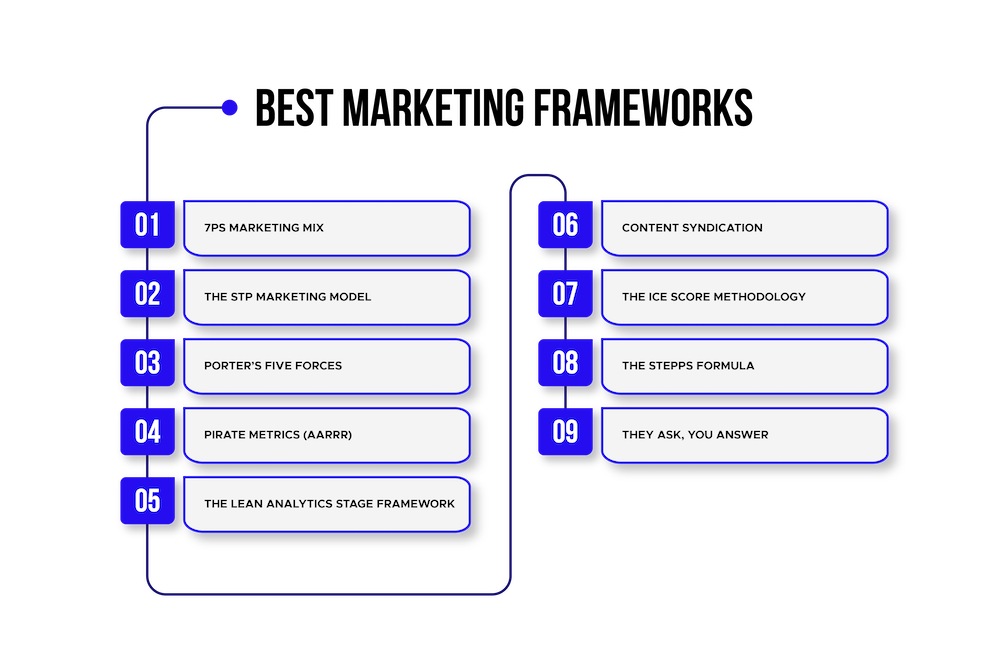
1. 7Ps Marketing Mix
7Ps Marketing Mix, a comprehensive framework that extends the traditional 4Ps concept to fit the modern marketing landscape.
This model is crucial for business owners to understand as it provides a holistic view of the various factors influencing marketing success.
The 7Ps Marketing Mix: A Detailed Exploration
- Product: At the heart of the 7Ps framework is the Product. This entails not just what you are selling but also how it meets customer needs, its quality, the problems it solves, and how it differs from competitors. For a business owner, this means focusing on product development, design, features, and ensuring it aligns with customer expectations and demands.
- Price: Price refers to how much your product or service costs. This is not just about the monetary value but also encompasses discounts, payment terms, customer perceived value, and pricing strategy relative to competitors. Pricing decisions directly impact your profitability and market positioning.
- Place: Place is all about distribution and logistics – where and how your product is sold. This includes retail locations, online presence, distribution channels, market coverage, and logistics. The right ‘place’ ensures your product is accessible to your target audience in the most convenient and efficient way.
- Promotion: Promotion covers all the ways you communicate with your target market to raise awareness and persuade them to purchase. This includes advertising, sales promotions, public relations, direct marketing, and digital marketing. Effective promotion increases visibility and drives customer engagement.
- People: In the extended marketing mix, People refer to everyone involved in both the creation and delivery of the product or service – from employees to customer service. The quality of interactions between your staff and customers can significantly influence the customer’s perception and experience with your brand.
- Process: Process is about the delivery of your service – the actual procedures, mechanisms, and flow of activities by which the service is delivered. This includes the customer journey, service standards, and the efficiency of operations. Streamlining processes can enhance customer experience and operational efficiency.
- Physical Evidence: Finally, Physical Evidence is the tangible proof or elements of a service that customers experience. This can include the physical environment where the service is delivered, the layout, branding, packaging, and even online presence. It’s crucial as it helps customers make tangible what is often an intangible service.
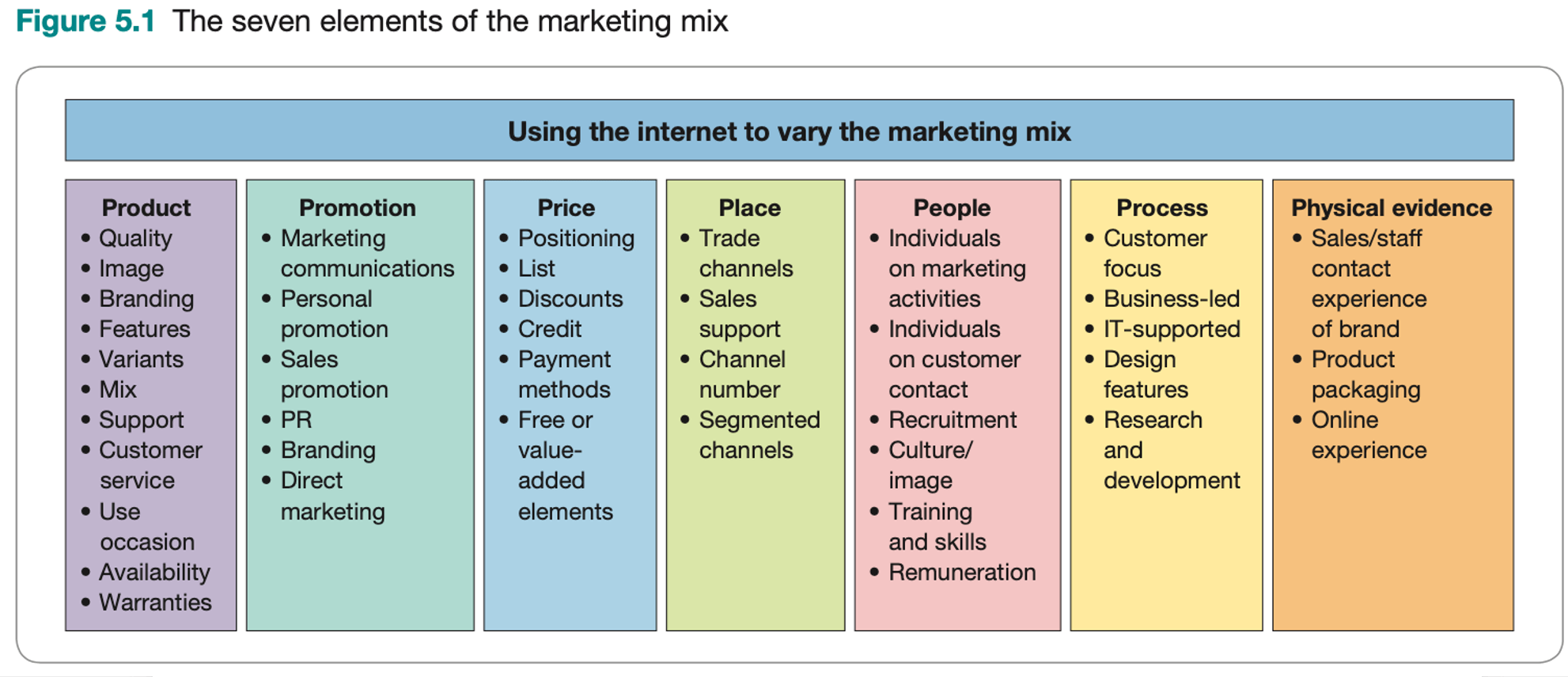
2. The STP Marketing Model
The STP Marketing Model, encompassing Segmentation, Targeting, and Positioning, is a strategic approach in marketing that focuses on identifying specific segments within a market, targeting these segments effectively, and positioning your brand in a way that resonates with each segment.
Let’s explore each of these components:
1. Segmentation:
Understanding Segmentation: This is the process of dividing a broad market into distinct subsets of consumers who have common needs, interests, and priorities.
It involves identifying various basis for segmenting the market, such as demographics, psychographics, geographic, and behavioural factors.
Benefits for Business Owners: For a business owner, segmentation allows for a more focused and efficient allocation of marketing resources.
By understanding the unique needs and preferences of different market segments, businesses can tailor their products and marketing strategies to meet these specific demands.
2. Targeting:
Choosing Your Audience: Once the market is segmented, targeting involves selecting one or more of these segments to focus your marketing efforts on.
It’s about choosing the segment or segments that your business is best equipped to serve and where the most opportunity lies.
Strategic Advantage: Effective targeting helps businesses concentrate their efforts on the most profitable segments. This can lead to more effective and cost-efficient marketing, better customer relationships, and higher return on investment.
3. Positioning:
Crafting Your Market Position: Positioning is about how you want your brand, product, or service to be perceived in the minds of your target audience. It involves creating a distinct image and identity that differentiates your offering from competitors.
Importance in Marketing Strategy: Proper positioning ensures that marketing messages resonate more deeply with the targeted audience, fostering stronger brand loyalty and preference.
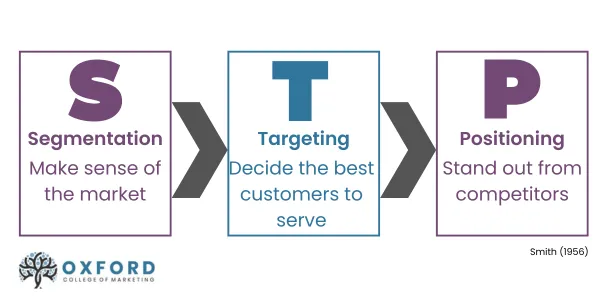
It’s about aligning your marketing message with the specific needs and desires of your target segments, ensuring that your brand stands out in a crowded marketplace.
3. Porter’s Five Forces
Porter’s Five Forces is a powerful tool for analysing the competitive environment of a business. Developed by Michael E. Porter, it goes beyond internal factors, focusing instead on external elements that impact a business’s profitability and strategy.
This model is crucial for business owners as it provides insights into potential pressures in the market and guides strategic decision-making. Let’s delve into each of the five forces:
1. Supplier Power
Control of Suppliers: This force examines how much power suppliers to your business have. High supplier power occurs when suppliers are few in number, offer unique products, or if switching suppliers is costly or difficult.
Impact on Business Owners: Understanding supplier power helps business owners negotiate better terms, diversify supply sources, or even integrate vertically to reduce dependency on powerful suppliers.
2. Buyer Power
Influence of Customers: Buyer power assesses the impact customers have on your business. It is high when buyers are few and purchase in large volumes, or when products are standardised, making switching between suppliers easy.
Strategic Importance: Knowing the power of buyers enables businesses to tailor strategies, such as enhancing product differentiation, improving customer service, or implementing loyalty programs to reduce buyer power.
3. Threat of Substitution
Availability of Alternatives: This force looks at the likelihood and ease with which customers can substitute your product or service with something else. High threat exists when there are many alternative products or services.
Business Strategy: Businesses need to innovate, improve product quality, or differentiate their offerings to reduce the threat of substitutes.
4. Threat of New Entry
Entry Barriers: It analyses how easy it is for new competitors to enter the market. Factors like high capital requirements, strong brand loyalty, or regulatory barriers can reduce this threat.
Implications for Business Owners: Understanding this helps in creating barriers to entry such as patent protection, capitalising on economies of scale, or developing strong brand recognition.
5. Competitive Rivalry
Intensity of Competition: This force examines the degree of competition in the industry. High rivalry is characterised by many competitors, slow industry growth, or lack of differentiation.
Strategies for Businesses: To cope with high competitive rivalry, businesses might focus on market segmentation, innovation, or cost leadership strategies.
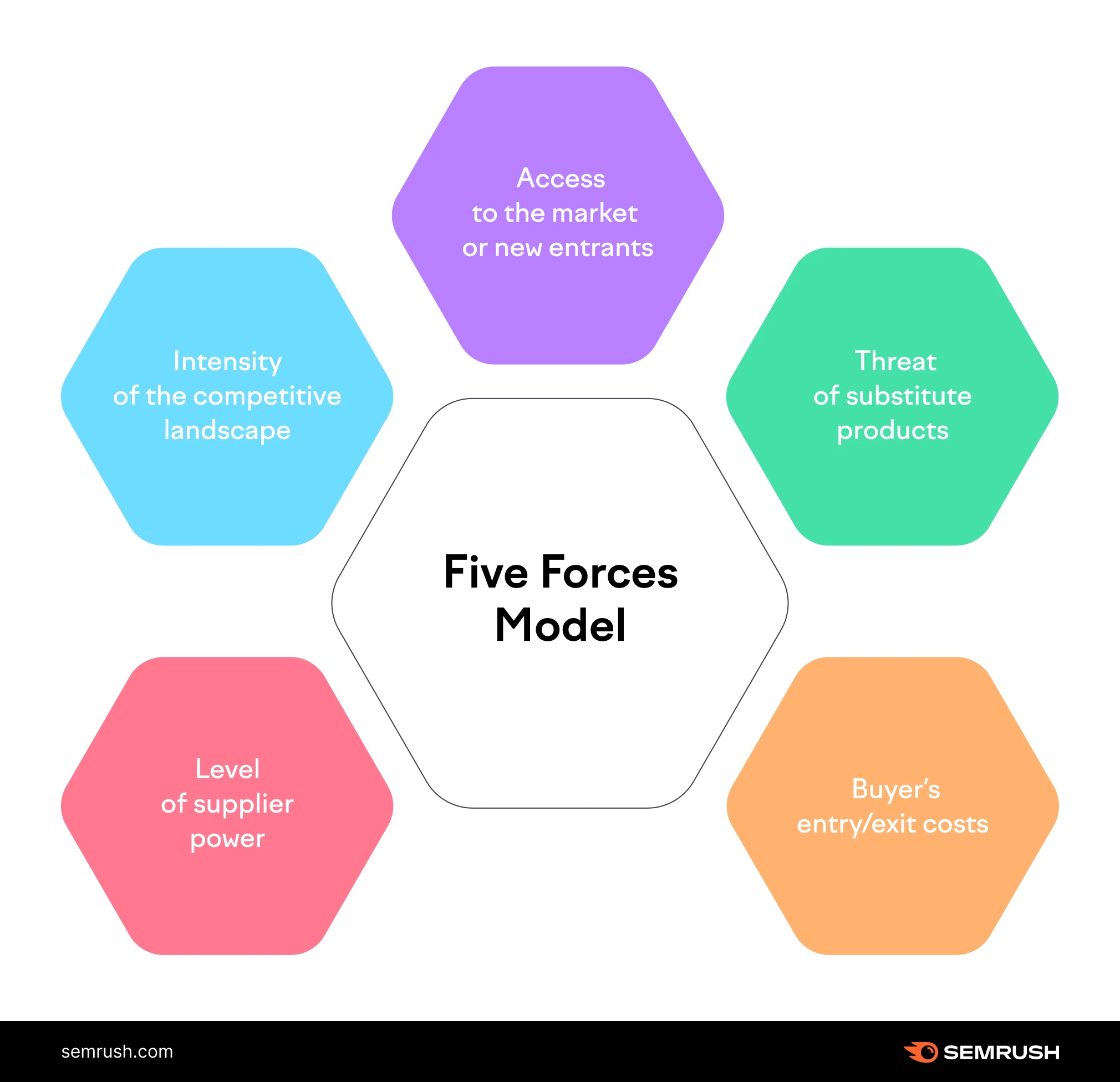
For business owners, Porter’s Five Forces framework offers a comprehensive view of the external competitive landscape.
It enables them to anticipate challenges, understand where power lies in their business environment, and strategise accordingly to improve their market position and profitability.
This analysis is crucial for creating strategies that not only respond to the current competitive environment but also shape a sustainable future for the business.
4. Pirate Metrics (AARRR)
Pirate Metrics, also known as the AARRR framework, is a modern marketing model developed by Dave McClure.
It’s particularly effective for e-commerce businesses, focusing on the customer journey from the initial contact point to the final stage of customer advocacy.
The acronym AARRR stands for Acquisition, Activation, Retention, Revenue, and Referral. Let’s break down each stage:
1. Acquisition
Attracting Customers: This is the process of attracting potential customers to your business. For e-commerce, this could mean visitors to your website or users signing up for a newsletter.
Strategies for Business Owners: Effective acquisition strategies may include search engine optimization (SEO), pay-per-click (PPC) advertising, social media campaigns, and content marketing.
2. Activation
First Positive Experience: After acquiring users, the next step is to ensure they have a great first experience with your product or service. This could be making a first purchase, using a product, or engaging with a service.
Enhancing User Experience: Business owners can improve activation by focusing on user experience, offering introductory tutorials, or providing incentives for the first purchase.
3. Retention
Keeping Customers Engaged: Retention involves encouraging customers to continue using your product or service. High retention rates indicate customer satisfaction and product or service stickiness.
Strategies for Engagement:
This can be achieved through regular updates, loyalty programs, personalised communication, or exceptional customer service.
4. Revenue
Monetisation Strategy: This stage is where the business starts earning money from its customers. The goal is to convert engaged users into paying customers effectively.
Business Model Optimisation: Tactics to increase revenue include optimising pricing strategies, upselling, and cross-selling products or services.
5. Referral
Customer Advocacy: The final stage is where satisfied customers refer others to your business. This is a sign of brand loyalty and can lead to a significant increase in acquisition.
Encouraging Referrals: Implementing referral programs, offering incentives for referrals, and maintaining high product quality and customer service are effective ways to encourage referrals.
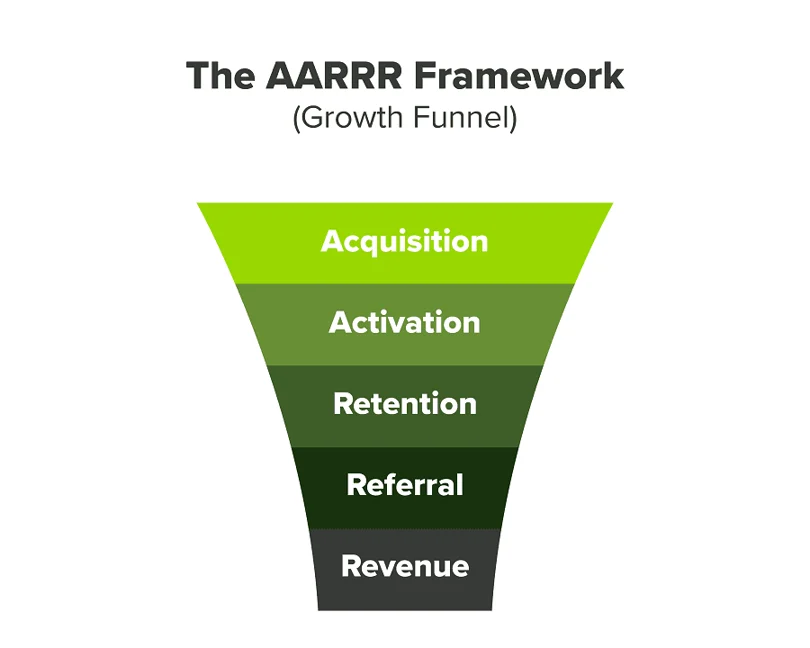
For business owners, especially in the e-commerce sector, Pirate Metrics provide a comprehensive view of the customer journey.
By focusing on each stage of AARRR, businesses can identify areas for improvement, enhance customer interaction, and ultimately drive growth and profitability. This framework is instrumental in guiding strategic decisions that enhance customer experience and foster long-term business success.
5. The Lean Analytics Stage Framework
The Lean Analytics Stage Framework is particularly beneficial for startups and growing businesses. Developed to help such businesses measure and grow effectively.
It revolves around five key stages: Empathy, Stickiness, Virality, Revenue, and Scale. Each stage represents a critical step in the business development process, focusing on understanding customer needs and scaling the business accordingly.
Let’s explore each stage:
1. Empathy
Understanding Customer Needs: This initial stage is all about gaining a deep understanding of your customers’ needs and pain points. It involves engaging with customers, gathering feedback, and empathising with their experiences.
Application for Startups: For a startup, this means conducting market research, customer interviews, and surveys to validate business ideas and understand what truly resonates with the target audience.
2. Stickiness
Engaging and Retaining Customers: Once you understand your customers, the next step is to create a product or service that ‘sticks’ – meaning customers come back repeatedly. This involves measuring user engagement and retention.
Strategy for Growth: Focus on refining your product or service based on customer feedback, enhancing user experience, and ensuring that your offering is indispensable to your customers.
3. Virality
Spreading the Word: This stage is about leveraging your existing customer base to acquire new customers, essentially growing your business organically.
Tactics for Startups: Implement referral programs, encourage social sharing, and create content that your users are eager to share. This not only broadens your reach but also enhances credibility through word-of-mouth.
4. Revenue
Monetisation and Profitability: After establishing a sticky and potentially viral product, the focus shifts to monetisation strategies. It’s about figuring out how to make sustainable revenue.
Revenue Strategies: Experiment with different revenue models like subscription fees, freemium models, or in-app purchases to identify what works best for your startup.
5. Scale
Expanding the Business: The final stage is scaling the business. This involves expanding your market reach, exploring new markets, and scaling your operations to meet increased demand.
Scaling Effectively: Ensure that the infrastructure, both technological and human, is in place to support growth. It’s also about maintaining the quality of the product or service as you scale.
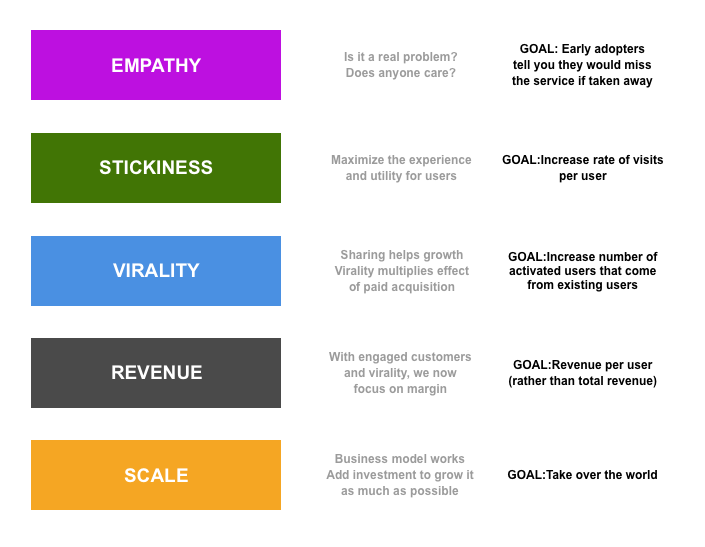
For business owners and startups, the Lean Analytics Stage Framework offers a structured approach to growing a business.
By focusing on each stage, businesses can ensure that they are not only meeting the needs of their customers but also building a foundation for sustainable growth and profitability.
This framework helps in making data-driven decisions, prioritising resources effectively, and navigating the complexities of scaling a business.
6. The Hook Model
The Hook Model, devised by Nir Eyal, is a compelling framework for creating habit-forming products and services.
It operates on the principle of building a loop that entices users to return repeatedly, fostering habitual use. This model is exceptionally valuable for understanding and influencing customer behaviour, and it’s highly relevant for businesses aiming to increase customer engagement and loyalty.
The model comprises four key elements: Trigger, Action, Variable Reward, and Investment. Let’s delve into each of these components:
1. Trigger
Cue for User Engagement: Triggers are cues that prompt users to initiate a behaviour. They can be external, like an email notification, or internal, based on emotions or routines.
Importance for Businesses: Understanding what triggers your target audience is crucial. For business owners, identifying the right triggers can lead to effective marketing strategies that drive user engagement.
2. Action
The Behaviour Itself: Following the trigger, the action is the behaviour done in anticipation of a reward. This should be simple and straightforward, making it easy for the user to take the desired action.
Simplifying User Interaction: For a product to become habit-forming, the action phase must be as frictionless as possible. Simplifying user interaction is key to ensuring that users regularly engage with the product.
3. Variable Reward
Fulfilling User’s Needs: This stage involves providing rewards that satisfy the users’ needs and keep them interested. Variable rewards are crucial as they create a sense of unpredictability and curiosity, which is psychologically engaging.
Creating Compelling Experiences: By providing varied and unexpected rewards, businesses can create compelling user experiences that lead to repeated engagement.
4. Investment
User’s Contribution to the Product: The investment phase is where the user puts something into the product, like time, data, effort, social capital, or money. This increases the likelihood of returning because of a sense of personal investment.
Encouraging Commitment: Encouraging users to make small investments in your product can lead to increased loyalty and the likelihood of them becoming habitual users.
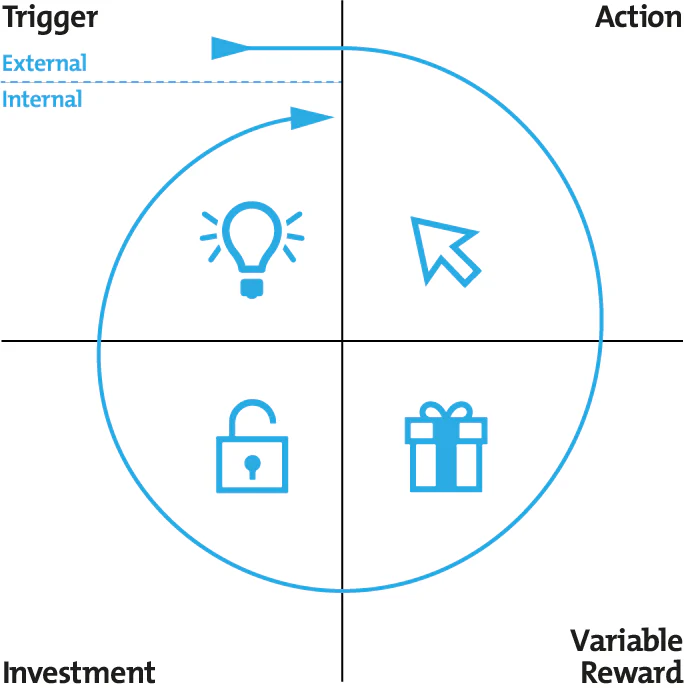
For business owners, the Hook Model is a powerful tool for creating products that users keep coming back to.
By incorporating these elements into product design and marketing strategies, businesses can drive higher user engagement, create loyal customer bases, and ultimately, ensure the long-term success of their products.
Understanding and applying the Hook Model can be a game-changer in today’s competitive market, where customer engagement is a key driver of growth.
7. The ICE Score Methodology
The ICE Score Methodology is a straightforward yet effective tool for evaluating potential growth strategies and channels, particularly useful for startups and businesses looking to optimize their resources.
Developed as a prioritise technique, it helps in assessing the potential value of new ideas or projects based on three key criteria: Impact, Confidence, and Effort.
This method is instrumental for businesses to make informed decisions on where to focus their growth efforts. Let’s explore each aspect:
1. Impact
Assessing the Potential Effect: The ‘Impact’ refers to the potential effect a particular initiative or channel could have on the business. It answers the question, “How much of an effect will this have on our key metrics if it succeeds?”
For Business Owners: Determining the impact helps business owners prioritize projects that could lead to significant improvements in areas such as user acquisition, revenue, or customer engagement.
2. Confidence
Estimating the Likelihood of Success: Confidence measures how certain you are about your estimates and the potential success of the initiative. This could be based on data, previous experiences, or industry benchmarks.
Strategic Significance: For a business, it’s crucial to invest in channels or strategies where there is a high degree of confidence to reduce the risk of resource wastage and to increase the likelihood of achieving the desired outcomes.
3. Effort
Evaluating Required Resources: Effort assesses the amount of time, resources, and energy required to implement the initiative. It considers the complexity and resource intensity of the project.
Resource Allocation for Businesses: This is particularly important for business owners to understand as it helps in allocating resources efficiently.
Focusing on initiatives that require minimal effort but offer high impact can be a smart strategy, especially for businesses with limited resources.
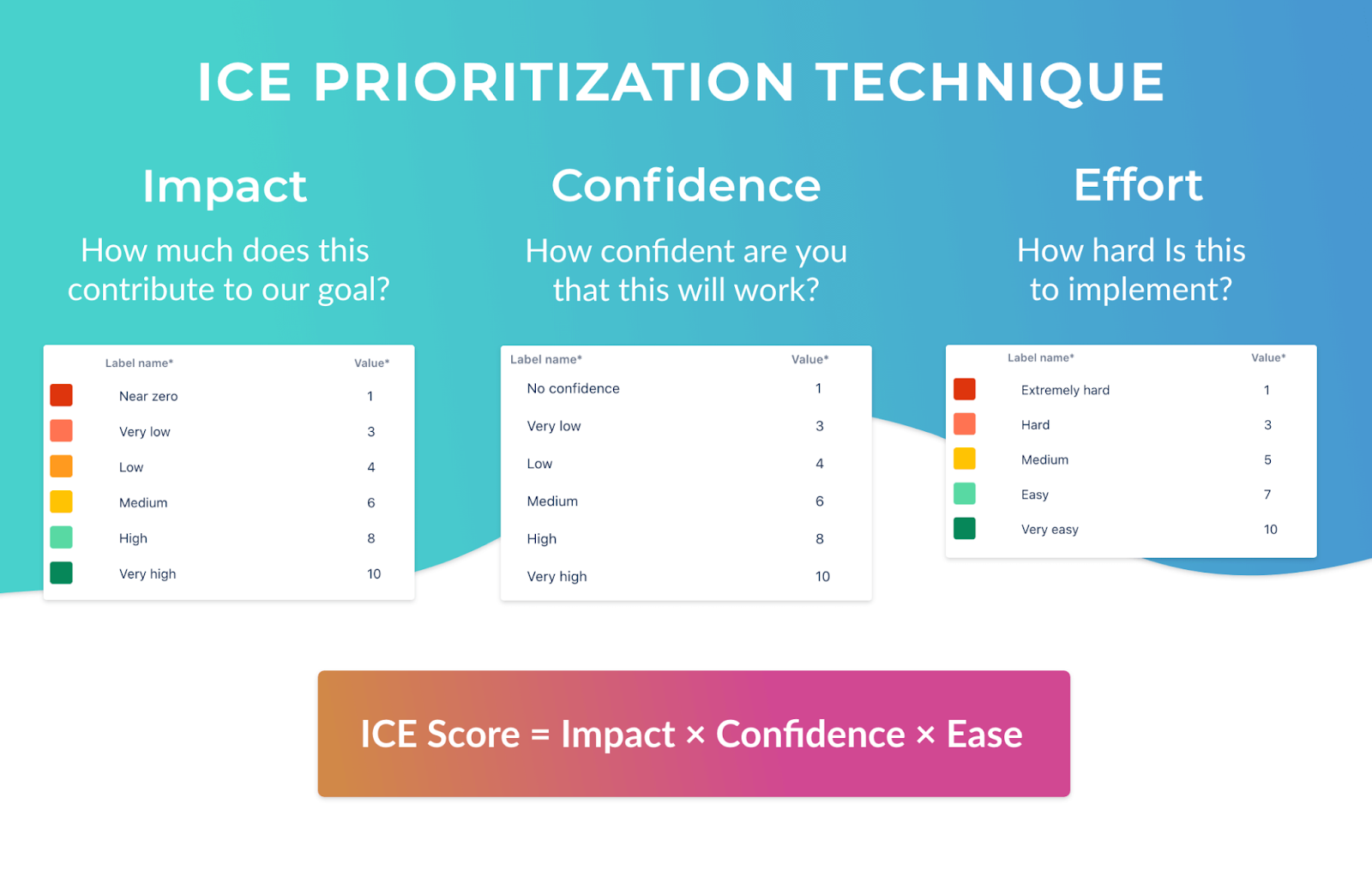
To calculate an ICE score, rate each criterion (Impact, Confidence, Effort) on a scale (typically from 1 to 10), and then calculate the average.
This scoring system helps business owners objectively compare different growth initiatives, making it easier to decide which ones to pursue.
By focusing on the initiatives with the highest ICE scores, businesses can optimize their growth efforts, ensuring that they are investing their time and resources in the most promising opportunities.
8. The STEPPS Formula
The STEPPS Formula, developed by Jonah Berger, is a strategic approach designed to create content that is inherently shareable and engaging, often referred to as ‘contagious content.’
This formula is grounded in six key principles: Social Currency, Triggers, Emotion, Public, Practical Value, and Stories. Each of these elements contributes to the likelihood of content being shared and resonating with a wide audience.
Let’s explore each of these principles:
1. Social Currency
Sharing What Makes Us Look Good: Social Currency revolves around the idea that people share things that make them look good or help them craft a desired identity. Content that is surprising, interesting, or exclusive provides social currency.
For Businesses: By creating content that makes people feel in the know or ahead of the curve, businesses can encourage sharing, enhancing brand visibility and engagement.
2. Triggers
Top of Mind, Tip of Tongue: Triggers are about creating content associated with everyday activities or common thoughts, making your product or idea readily ‘triggered’ in people’s minds.
Application in Marketing: Implementing triggers in marketing means linking your product to common occurrences or prevalent ideas in society, thereby keeping your brand at the forefront of consumers’ minds.
3. Emotion
Content That Evokes Feelings: When we care, we share. Emotional content, especially that which evokes high-arousal emotions like awe, excitement, or amusement, is more likely to be shared.
Strategy for Engagement: Businesses should aim to create content that strikes an emotional chord with the audience, thereby increasing the likelihood of it being shared.
4. Public
Built to Show, Built to Grow: The principle of Public is about making actions or products observable. If something is built to show, it’s built to grow.
Visibility for Brands: Designing products or creating content that is visually noticeable and recognisable can drive word-of-mouth and social sharing.
5. Practical Value
Useful Information Gets Shared: People like to help others. Content that has practical, useful information is more likely to be shared as it provides value to others.
Focus for Businesses: Creating content that is helpful, informative, or provides utility can encourage sharing, thereby reaching a wider audience.
6. Stories
Information Wrapped in Stories: Stories act as vessels carrying messages. People are more likely to share a good story, and if your product or brand is woven into the narrative, it gets shared along.
Narrative Marketing: Crafting compelling stories that embed your brand or product can lead to greater shareability and memorability.
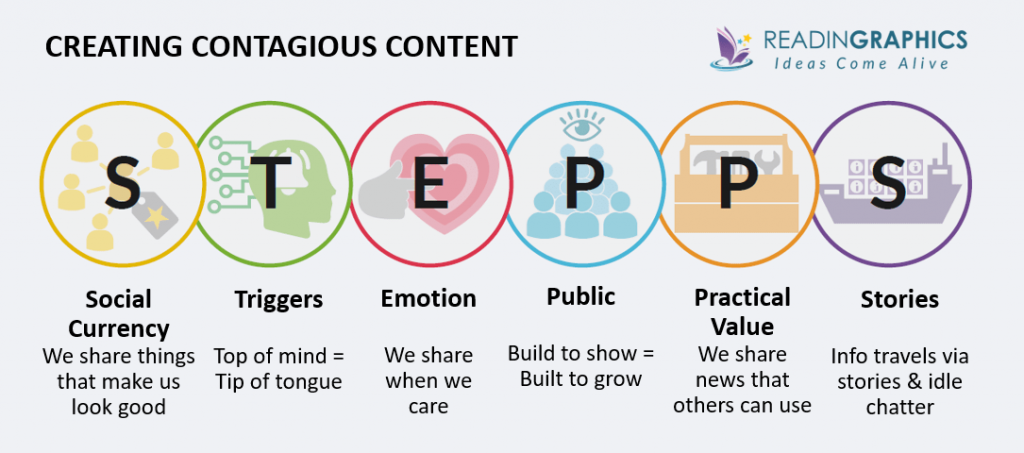
Implementing the STEPPS formula in content creation can transform the way a business engages with its audience.
By focusing on these six principles, businesses can create content that not only captures attention but also encourages sharing, significantly increasing the reach and impact of their marketing efforts.
9. They Ask, You Answer
The “They Ask, You Answer” framework is a customer-centric marketing strategy that emphasizes transparency and engagement.
Developed by Marcus Sheridan, it is rooted in the philosophy of addressing customer queries openly and comprehensively, primarily through content on a company’s website.
This approach is built on the understanding that customers today are incredibly informed and often carry out extensive research before making a purchase decision.
This approach is centered around five key topics that businesses should comprehensively cover on their website:
- Pricing and Costs: Provide clear information about the prices of your products or services, including factors that might affect these costs. This openness about pricing helps in building trust with potential customers.
- Problems and Issues: Discuss any potential drawbacks or common issues related to your products or services. Being upfront about shortcomings demonstrates honesty and builds credibility.
- Comparisons: Offer objective comparisons between your products and those of your competitors. This helps customers make informed decisions while showcasing your confidence in your offerings.
- Reviews and Evaluations: Share reviews and evaluations of your products or services. Including both positive and negative reviews can enhance your reputation for transparency.
- Best in Class: Provide information about what makes certain products or services the best in their category. This helps position your offerings as top choices in the market.
Implementing the “They Ask, You Answer” framework can transform how businesses interact with their customers. By prioritizing honesty and comprehensive information, companies not only enhance their customer engagement but also improve their overall marketing and sales effectiveness.
Conclusion
In summary, the choice of a marketing strategy framework should be tailored to your business’s unique needs and market position.
By carefully selecting and implementing the right framework, you can enhance your marketing effectiveness, driving growth and success. For more insights into selecting and implementing an effective marketing strategy framework, or for any other marketing needs, visit Neu Entity.
Related Articles
Let’s Talk!
If what you see here is relevant for you and can help you grow your business or organisation, we’d love to discuss further with you. Drop us a message or schedule an appointment with us.




